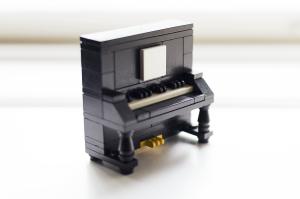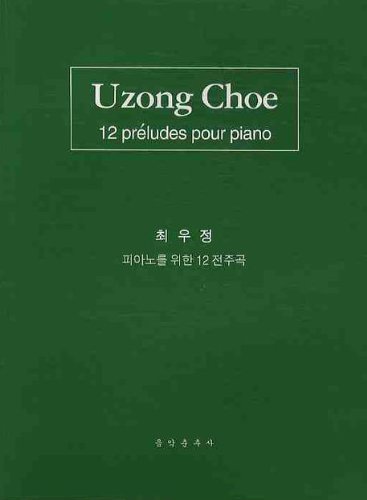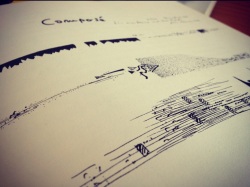Musical Fusion in Uzong Choe’s Preludes, Book 1 (2004)
Korean composer Uzong Choe’s Preludes exemplify an important facet of contemporary classical music, combining accessible listening with a cosmopolitan sense of style.
The musical eclecticism of these works reflect the synthesis of different musical and technical styles influenced by various European modes. These works are meant not just as pedagogical tools to improve one’s technique to the particular genre, but are also incredible concert pieces. The first book of 12 Preludes was published in 2004, and Books 2 and 3 are works in progress.
Much like études, individual pieces concentrate on particular technical issues, such as major and minor triads (Prelude 9), Ostinato (Prelude 2), and jazz fugue (Prelude 12). Approach wise, Choe evokes Bartok’s Mikrokosmos or Corigliano’s Etude Fantasy, which focuses on particular techniques like fifths and thirds, or trills. The Preludes explore expressive possibilities of sound and styles: Prelude 8 has a more minimalistic sound, with repeating action that reminds one of John Adams’s piano works. Some of these works employ early music as well as popular music. Prelude 7 is very spare and restrained, its main idea on an Renaissance motet “Oculus non vidit,” while Prelude 10 frames a chant melody within six different rhythmic patterns and heavy chords and tone clusters. Prelude 12 concludes the current set with fortississimo tone clusters and dissonant harmonies.
These works are a must-listen, showcasing the versatile stylings of a highly wide-ranging composer.
Dualities of Roles and Identity of Musicians in the 21st Century
Renowned Pianist Grigory Sokolov has a more traditional career. He only gives traditional concerts in certain parts of Europe and venues so that travel is light, and so that he can create work in the space where he is comfortable. On the other hand, legendary pianist Daniel Barenboim has a very multifaceted career. Not only does he give concerts, but he also manufactures pianos, started a music school and orchestra, and has a large online presence in classical content creation.
In the 21st century, Sokolov’s career is more of the exception than the norm. It is almost impossible for even extremely talented artists to maintain a living simply performing full time. Many of my music students have been discouraged from studying music due to the uncertainty of the economy. In fact, most classical musicians have to teach or turn to other forms of work to supplement their performance income. Side hustles have become increasingly common with the rise of the gig economy, and many musicians make profitable side income taking on a variety of projects. Side hustles often evolve into full-time hustles depending on how diligent any musician applies themselves to their craft.
This is where entrepreneurship comes in. Entrepreneurship is about doing something you love while making money from it. But what stops most artists from taking on entrepreneurship is fear of the unknown and lack of awareness about where to start. What many musicians don’t realize is that creativity isn’t just an asset to their art — it can be a huge asset to their business as well, as there are many people looking for examples of creativity in business. With the digital age and the rise of new technologies, imagination and creativity are very much in demand, should any potential entrepreneur know where to look. What circumstances factor into whether or not classical musicians take on the challenge of being an entrepreneur? How do the artist’s goals and priorities determine their path as they decide what type of musician they want to be?
Recommended Find: Hikaye
This review was originally published in the American Record Guide May/Jun2020, Vol. 83, Issue 3, p. 155 issue.
KONSTANTINIDIS: 8 Greek Island Dances; BABADJANIAN: 6 Pictures; ERKIN: Duyuslar; MOKRANJAC: 6 Dances; GALLAND: Jeux; BLOCH: Ex-voto; FRANCK: Danse Lente; TAKEMITSU: Litany
Isil Bengi, p—Fuga Libera 759—59 minutes
This is a fascinating and unique program of rhythmic works by a wide array of composers. Turkish-Belgian pianist Isil Bengi is a powerful and creative pianist, introducing listeners to music from Armenia, Switzerland, Japan, Belgium, Greece, and Yugoslavia. These works are often folk-infused, such as the 8 Greek Island dances. Babadjanian’s 6 Pictures are often quite spare and austere, reminiscent of Prokofieff’s Visions Fugitives.
The playing is very poignant. Mokranjac’s 6 Dances have a neo-classical element mixed with folk. The high point of the program is Stephane Galland’s killer set of pieces called Jeux. He is known as a jazz musician, and his last movement is a tour de force of perpetual rhythm—a monster of a piece.
A wonderful debut album.
Piano Practice Tip #1: Less is More
 I have been teaching my students that the fewer notes or units you practice, the more information you retain.
I have been teaching my students that the fewer notes or units you practice, the more information you retain.
The idea is simple. When you practice, aim for fewer notes to play. Work on small sections, dive in to the root, get to the point, and always think. Some tips:
- fingerings
- coordination
- practicing hands separate
- listening to phrasing
- rhythm alteration
 This tip is about applying discipline to the details more so than anything else. This advice is meant to cultivate a mindful approach that will net positive results, and importantly, a keen attention to detail and an ear for the piece’s components.
This tip is about applying discipline to the details more so than anything else. This advice is meant to cultivate a mindful approach that will net positive results, and importantly, a keen attention to detail and an ear for the piece’s components.
Article first published as Concert Review: Pianist Kwiran Lee at the Sejong Chamber Hall, 6/16/14 on Blogcritics.
Acclaimed pianist and Ewha Woman’s University faculty member Kwiran Lee performed a dynamic and engaging solo recital of Bach, Mozart, and Schumann at Sejong Chamber Hall on June 16 at 7:30 p.m. A former student of renowned fortepianist Malcolm Bilson, Ms. Lee’s extensive background on period instruments shows in her treatment of the works on her program, even on a modern concert grand.
Attributes of her playing include delicacy of touch and clear interpretations, with subtle hints of pedal. This appears in the opening work, the vibrant Bach’s Italian Concerto, a concerto in microcosm. Aside from slight rushing in the first movement, Ms. Lee is precisely rhythmic without sounding mechanical, and reveals great command of the keyboard. Her sound is never forced or unnecessarily tense, especially in the spirited third movement. A relaxed approach to the keys and a supple, fluid tone marks her playing. Her performance of Mozart’s Piano Sonata in E-flat, K. 282 is sensitive and translucent, her well-balanced phrasing true to the style of that period. Her handling of the cantabile first movement abounds with nuance and feeling.
The same inclination towards understatement appears in the massive Davidsbundlertanze, which concludes the program. Although there are clearly no technical limitations to her playing, Ms. Lee’s instinct is for the more introverted pieces in the set, played with great warmth and intimacy. It is wonderful to see her range exhibited in the musical “dialogues,” as she transitions from the dreamy Eusebius to the impetuous Florestan.
Ms. Lee is also known for her premieres of contemporary Korean works for piano, many of which she includes in her concert programming. I missed the inclusion, but nevertheless enjoyed this wonderful night of music.


